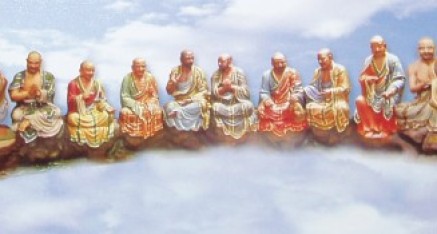Arhat literally translates as worthy of offerings, without birth, and killer of thieves. An Arhat is an eminent monk or saint who has achieved a level of enlightenment, but is not yet a Buddha. An Arhat or Lohan is one who has overcome outward manifestation of afflicting emotions, but who has not completely eliminated their psychic imprint. Although free of the cycle of birth and death, an Arhat is not fully enlightened. These holy beings are also called Venerable Ones or foe-destroyers. This is the first stage of liberation or ending the cycle of birth and death and goal of the lesser-vehicle sects such as the Theravada. The Arhat is said to be beyond both merit and demerit because, as he has abandoned all defilements, he can no longer perform evil actions; and as he has no more attachment, his virtuous actions no longer bear karmic fruit.
Progress on the path of an Arhat is measured by the person’s ability to weaken or eliminate the ten fetters which bind him to the cycle of birth and death, and which keep him from attaining Nirvana. There are four recognizable stages which mark his progress along the path. These are explained in relation to the ten fetters below.
The Four Stages of the Arhat Path
At the first stage is the Stream-winner or Stream-enterer (srotapanna), that is, one who has entered the “stream” that eventually leads to the “Ocean of Nirvana.” When he is at this stage, his insight is powerful enough to remove the first three fetters, namely:
(1) the belief in the existence of permanent self;
(2) doubt in the ability of the Three Gems to lead him towards the goals; and
(3) the mistaken belief that moral rules and ascetic rites alone are sufficient to lead a person to Enlightenment.
On attaining this first stage, the would be Arhat will no longer be reborn in any of the lower realms of existence. He will be reborn no more than seven times in the human or heavenly planes of existence before he attains Nirvana.
As he makes further progress and perfects his insight still more, he reaches the second stage of the Once-Returner (sakrdagamin). After this life, he will be reborn only once more as a human being. In that rebirth, he would attain Nirvana. At this stage, he has also succeeded in weakening the fourth and fifth fetters. These are:
(4) attachment to sensual desire; and
(5) ill will.
The third stage is that of the Non-Returner or no-more-rebirths (anagamin). At this stage, he completely removes the fourth and fifth fetters of attachment to sensual desire and ill will. The Non-Returner will no longer be reborn in the human realm; he will be reborn in one of the Pure Abodes in the heavens where he will attain Nirvana. At this stage, the first five fetters have been totally removed.
At the fourth stage, he makes the final advance towards becoming an arhat or Foe-destroyer who attains nirvana because he has broken all the ten fetters, the last five of which are:
(6) desire for existence in the worlds of Form;
(7) desire for existence in the Formless Worlds;
(8) conceit;
(9) restlessness; and
(10) ignorance.
The career of the Arhat is like the career of a student in that development is measured by the highest stage or level he has achieved so far. When a secondary school student progress in stages from that of a Freshman to that of a Senior, his knowledge and mastery of skill increase with each higher level achieved. Eventually, he graduates from school when he passes his final year examinations. In the same way, the would be Arhat overcomes more and more of the fetters at each higher stage of his development. When he successfully passes the fourth stage, he reaches the end of his career and is no longer subject to rebirth. However, he is not yet at the highest stage. He is not yet a Buddha.
One who is on any of the first three stages on this path is called a “sekha,” or a Striver-on-the-Path.
The Sixteen Arhats shown here all remained in this world to help living beings after Shakyamuni Buddha departed. They are: Suvinda, Svaka, Nagasena, Panthaka, Pindolabharadvja, Cudapanthaka, Rahula, Kanakabharadvaja, Nakula, Kanakavatsa, Bhadra, Vajraputra, Karika, Vanavasin, Ajita, and Ingata.


